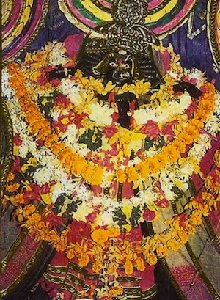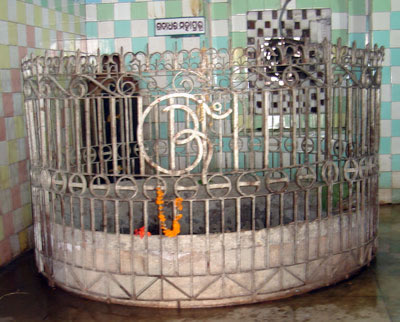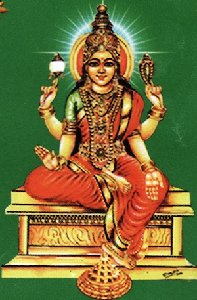 The Birja Devi Temple, Jajpur was consecrated as Dakshayanis navel part fallen here. The presiding deity of Jajpur Asta dasha shakti peetha is Goddess Girija Devi. Goddess Girija Devi is also worshiped with various names such as Goddess Birija Devi, Goddess Virija. The temple of Sri Girija Devi is a very small construction when we compare it to Puri Jagannath Temple or Lingraja Temple of bhubaneshwar. Nobody knows the exact time of the Girija Devi temples construction. But it was renovated in the 13th Century. Jajpur is also called as Baithangi Theertha or Birija Kshetram or Oddyana Peetha (an Oddiyana is an ornament worn by a woman around her navel).
The Birja Devi Temple, Jajpur was consecrated as Dakshayanis navel part fallen here. The presiding deity of Jajpur Asta dasha shakti peetha is Goddess Girija Devi. Goddess Girija Devi is also worshiped with various names such as Goddess Birija Devi, Goddess Virija. The temple of Sri Girija Devi is a very small construction when we compare it to Puri Jagannath Temple or Lingraja Temple of bhubaneshwar. Nobody knows the exact time of the Girija Devi temples construction. But it was renovated in the 13th Century. Jajpur is also called as Baithangi Theertha or Birija Kshetram or Oddyana Peetha (an Oddiyana is an ornament worn by a woman around her navel).
About Goddess
The Durga idol has two hands (dwibhuja), spearing the chest of Mahishasura with one hand and pulling his tail with the other. One of her feet is on a lion, and the other is on Mahishasura's chest. Mahishasura is depicted as a water buffalo. The idol's crown features Ganesha, a crescent and a lingam. The whole idol of Goddess Girija Devi is decorated with flower garlands and gold jewelry. We can see only the face of Goddess Birija. The idol is decorated with silver crown full of jewels. Goddess Girija Devi blesses her devotees with her pleasant smiling face and charming looks.
Another significance aspect of this temple is - a well near the main temple of Girija Devi in which devotees perform ritual rites to their ancestors (Pinda pradhaan). People believe that these Pindas will reach Kasi directly. It seems the depth of the well is somewhere around 4 to 5 feet but it never dried up till now.
History
There are two episodes to illustrate the glory and glamour of Biraja Ksetra or modern Jajpur that have been depicted beautifully in puranic texts.
Nabhi Gaya Inside Temple
There is a fathomless well in the close proximity of Goddess Biraja inside the compound which is known as Nabhikupa or Nabhigaya where piṇdas are offered to the ancestors. As it is a famous Pitr-Tirtha, Hindu religious people from all over India and abroad come over here for the purpose of offering piṇdas (oblations) to their ancestors in the course of their pilgrimage When Lord Vishnu kílled Gayasura by performing Yagna on his heart, Gayasuras feet were in Pada Gaya (Pithapuram, Andhra Pradesh), Navel in Nabhi Gaya (Oddhyana peetha) and head at Siro Gaya (Gaya).
 The episode in the Gaya Mahatmya section of the Vayu purana relates a story thus-In the Svetavaraha kalpa a very powerful demon Gaya, who was sincerely devoted to Lord Visnu, performed severe penance on the Kolahala Mountain for thousands of years in order to achieve utmost purity of body and mind. Gods became scared at his penance and approached Lord Visnu who accompanied them to the demon Gaya in order to grant his desire. The demon on the fulfillment of his desire, attained purity and whosoever touched his body went to Visnuloka (the abode of Lord Visnu) with a liberated soul. The Yamaloka (the abode of the God of death) was desolated Yama, the God of death, in the company of Indra (the God of rain) with other Gods approached Brahma (the creator) who sought the counsel of Visnu. At the advice of Visnu, Brahma entreated Gaya for giving away his pure body for the purpose of a sacrifice, Gaya readily agreed to the proposal and immediately laid down his physical form on the earth in a south-western direction where by his head rested on the Kolahala Mountain beside the river Falgu his navel on Biraja beside the river Vaitarani and his feet at Pithapuram beside the river Godavari, Brahma performed a sacrifice on the Navel of Gaya at Biraja. As Gaya's body was unstable and unfavorable for performing the sacrifice, he entreated Visnu and other Gods to help him make the body stable, Visnu wielded his Gada (club) and made Gaya's body stable. Gaya complained of his unnecessary torture though he submitted to the desire of the gods. So Visnu asked him to choose a boon for offering his body for a greater interest whereby Gaya chose that Brahma, Visnu and Siva may remain in the three Places where his navel, head and feet fell as long as the earth, mountains, the sun, the moon and the stars last and let the abodes of these three Gods turn in to Pitr-tirthas, The desire of Gaya was granted and Visnu remained at Gaya (kolahala mountain) where the head of the demon fell. Brahma adored the Biraja Ksetra or modern Jajpur where the navel fell and Siva was associated with Pithapuram where the feet rested. Thus the ancient Biraja Ksetra turned in to a Pitr Tirtha and Navi Gaya was evolved out of the navel of demon Gaya, The Biraja Ksetra mahatmya illustrates the same story with the slightest modification and justified Viraja Ksetra as a Pitr-Tirtha similar to Pada Gaya Tirtha at Pithapuram and Mastaka Gaya Tirtha beside the river falgu in Magadha or the present Bihar.
The episode in the Gaya Mahatmya section of the Vayu purana relates a story thus-In the Svetavaraha kalpa a very powerful demon Gaya, who was sincerely devoted to Lord Visnu, performed severe penance on the Kolahala Mountain for thousands of years in order to achieve utmost purity of body and mind. Gods became scared at his penance and approached Lord Visnu who accompanied them to the demon Gaya in order to grant his desire. The demon on the fulfillment of his desire, attained purity and whosoever touched his body went to Visnuloka (the abode of Lord Visnu) with a liberated soul. The Yamaloka (the abode of the God of death) was desolated Yama, the God of death, in the company of Indra (the God of rain) with other Gods approached Brahma (the creator) who sought the counsel of Visnu. At the advice of Visnu, Brahma entreated Gaya for giving away his pure body for the purpose of a sacrifice, Gaya readily agreed to the proposal and immediately laid down his physical form on the earth in a south-western direction where by his head rested on the Kolahala Mountain beside the river Falgu his navel on Biraja beside the river Vaitarani and his feet at Pithapuram beside the river Godavari, Brahma performed a sacrifice on the Navel of Gaya at Biraja. As Gaya's body was unstable and unfavorable for performing the sacrifice, he entreated Visnu and other Gods to help him make the body stable, Visnu wielded his Gada (club) and made Gaya's body stable. Gaya complained of his unnecessary torture though he submitted to the desire of the gods. So Visnu asked him to choose a boon for offering his body for a greater interest whereby Gaya chose that Brahma, Visnu and Siva may remain in the three Places where his navel, head and feet fell as long as the earth, mountains, the sun, the moon and the stars last and let the abodes of these three Gods turn in to Pitr-tirthas, The desire of Gaya was granted and Visnu remained at Gaya (kolahala mountain) where the head of the demon fell. Brahma adored the Biraja Ksetra or modern Jajpur where the navel fell and Siva was associated with Pithapuram where the feet rested. Thus the ancient Biraja Ksetra turned in to a Pitr Tirtha and Navi Gaya was evolved out of the navel of demon Gaya, The Biraja Ksetra mahatmya illustrates the same story with the slightest modification and justified Viraja Ksetra as a Pitr-Tirtha similar to Pada Gaya Tirtha at Pithapuram and Mastaka Gaya Tirtha beside the river falgu in Magadha or the present Bihar.
 The second episode craves for justifying Biraja Ksetra as a great sakti pitha that was known from the pre-Gupta period. Hence it is a post-facto attempt to put forth the revised version of an earlier tradition of Daksa - Yajna Vidhvamsan - prakarana to sanctify the place. Though the name of Biraja Ksetra is not found to be associated with any of the limbs of SATI in any of the earlier texts like Kurma purana and Matsya purana etc. Some latter texts of tantra have done so. The story of Daksa - Yajna - Vidhvamsana runs thus - SATI, the consort of Siva commits suicide in the sacrificial pit of his father Daksaprajapati listening to the invectives aimed at her husband Siva. At this Siva in a fit of rage carries sati's dead body on the shoulder and starts performing Tandava (a furious dance) dance that indicates the welcome of Pralaya or total destruction of the universe. At the request of the frightened gods, Visnu comes forward in order to save the universe and cuts down sati's body in to pieces by his wheel weapon. The limbs of Sati fell at different places of India and gave rise to sakta pithas, Sati's navel is said to have fallen in the VirajaKsetra and so it became known as Nabhipitha, a great saktapitha. However, the tradition goes that the Navel of the demon Gaya and Goddess Sati is the common element and in both the cases Visnu has cut down the body to cause the Navel fall as a result of which the place was glorified either as a Pitr-Tirtha or as a saktapitha. Here again there is an interlinking of the rise of sakti cult with the Vaishnavite faith in the form of an invisible amalgamation and mysterious process of assimilation between both the religious ideas.
The second episode craves for justifying Biraja Ksetra as a great sakti pitha that was known from the pre-Gupta period. Hence it is a post-facto attempt to put forth the revised version of an earlier tradition of Daksa - Yajna Vidhvamsan - prakarana to sanctify the place. Though the name of Biraja Ksetra is not found to be associated with any of the limbs of SATI in any of the earlier texts like Kurma purana and Matsya purana etc. Some latter texts of tantra have done so. The story of Daksa - Yajna - Vidhvamsana runs thus - SATI, the consort of Siva commits suicide in the sacrificial pit of his father Daksaprajapati listening to the invectives aimed at her husband Siva. At this Siva in a fit of rage carries sati's dead body on the shoulder and starts performing Tandava (a furious dance) dance that indicates the welcome of Pralaya or total destruction of the universe. At the request of the frightened gods, Visnu comes forward in order to save the universe and cuts down sati's body in to pieces by his wheel weapon. The limbs of Sati fell at different places of India and gave rise to sakta pithas, Sati's navel is said to have fallen in the VirajaKsetra and so it became known as Nabhipitha, a great saktapitha. However, the tradition goes that the Navel of the demon Gaya and Goddess Sati is the common element and in both the cases Visnu has cut down the body to cause the Navel fall as a result of which the place was glorified either as a Pitr-Tirtha or as a saktapitha. Here again there is an interlinking of the rise of sakti cult with the Vaishnavite faith in the form of an invisible amalgamation and mysterious process of assimilation between both the religious ideas.
There is a novel tradition here that people after offering pindas to their ancestors must have to pray to Goddess Biraja to receive their oblations on behalf of their ancestors instead of praying to lord Visnu as is customary everywhere in India. People from all over India come here to offer pindas to their ancestors at Nabhigaya and a visit to Goddess Biraja throughout the year. The best period for offering such pindas is during the Pitr-paksa (Mahalaya) in the month of September i.e. During the dark fortnight of the month of Bhadrapada.
Important Places to see in Jajpur
Brahma Kund
(A holy place where Brahma did Yagna) is also present near temple. This pond also considered as Nabhi kund.
Jagannath Temple
It's on the bank of Baitarani River. This temple is present on the other side of Jajpur town. Beside this temple, there is Laxmi temple. Also we can find Raksha Kali's temple nearby.
Siddheshwar Temple
Siddheshwar Temple is one of the oldest temple of Lord Shiva in Jajpur district.
Vaitharani River
At a small distance from Goddess Girija Devi temple, Vaitharani River flows. But now the river is full of polluted water. Dashashwametha Ghat is the most important ghat among all the ghats here. The temple of Lord Yamadharma raj is located here. People believe that one who dips in the holy river Vaitharini and worships Lord Yama would easily cross the River Vaitharini after death. It also said that the water of river Vaitharini has a magical power to treat diseases and can remove all the sins of devotees.